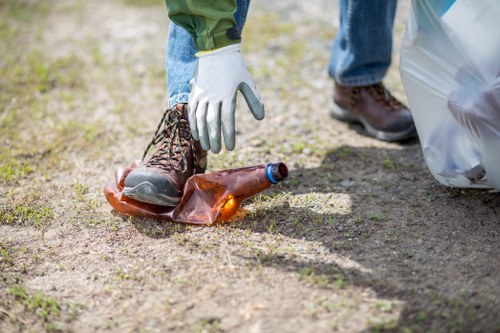Waste Collection Canary Wharf

Canary Wharf is a bustling financial district in London, home to some of the city’s tallest skyscrapers and a vibrant community. With such a high concentration of businesses and residents, efficient waste collection is essential to maintain cleanliness and sustainability in the area. This article explores the waste collection services in Canary Wharf, highlighting how they operate, the importance of proper waste management, and the role of the community in keeping the district clean.
Effective waste collection in Canary Wharf involves a combination of regular pickups, recycling programs, and specialized services for large businesses. The local council works closely with waste management companies to ensure that all types of waste are handled appropriately. From office buildings generating significant amounts of paper and electronic waste to residential areas producing household trash, the systems in place aim to minimize environmental impact.
Recycling is a cornerstone of Canary Wharf’s waste management strategy. Separate bins for paper, plastic, glass, and organic waste make it easier for residents and businesses to sort their waste correctly. Additionally, there are initiatives to reduce single-use plastics and encourage the use of reusable materials, further promoting sustainability in the area.

Types of Waste Collected
In Canary Wharf, waste collection services cater to a variety of waste types, each requiring specific handling methods to ensure efficiency and environmental compliance.
General Waste
General waste includes everyday items that are unsuitable for recycling or composting, such as non-recyclable plastics, food wrappers, and broken household items. This waste is typically collected weekly and transported to local landfills or waste-to-energy plants.
Recyclable Materials
Recyclable materials like paper, cardboard, glass bottles, and certain plastics are collected separately. Specialized bins are located throughout Canary Wharf to facilitate easy sorting by residents and businesses. Collected recyclables are then processed and reintroduced into the manufacturing cycle.
Organic Waste
Organic waste, including food scraps and garden waste, is composted to create nutrient-rich soil amendments. Composting reduces the volume of waste sent to landfills and supports sustainable gardening practices.

Scheduled Collection Timetables
Canary Wharf operates on a well-organized waste collection timetable to ensure that all areas are serviced regularly and efficiently.
Residential Areas
In residential zones, general waste is usually collected once a week, while recycling is picked up twice a week to accommodate the higher volume of materials. Organic waste collection occurs bi-weekly, providing ample time for composting and reducing the need for frequent pickups.
Commercial Buildings
Commercial buildings, such as office towers and retail spaces, require more frequent waste collection due to the higher output. Typically, these areas receive daily pickups for general waste and multiple pickups for recyclables and electronic waste, ensuring that large volumes are managed effectively.
Specialized Collection Services
For businesses that generate hazardous or bulky waste, specialized collection services are available. These services handle items like batteries, electronics, furniture, and other materials that require safe disposal and recycling methods.

Recycling Programs in Canary Wharf
Recycling is a critical component of waste management in Canary Wharf, with several programs designed to maximize the recycling rate and minimize environmental impact.
Paper and Cardboard Recycling
Dedicated bins for paper and cardboard make it easy for businesses and residents to recycle office supplies, packaging materials, and newspapers. Proper sorting ensures that these materials are efficiently processed and reused.
Plastic Recycling
Plastic recycling initiatives focus on collecting various types of plastic containers and packaging. Educational campaigns encourage the community to reduce single-use plastics and participate actively in recycling efforts.
Glass Recycling
Glass bottles and jars are collected separately to be recycled into new glass products. This process conserves resources and reduces the energy required to produce fresh glass from raw materials.

Community Involvement and Education
Community involvement plays a vital role in the success of waste collection and recycling programs in Canary Wharf. Educating residents and businesses about proper waste sorting and the benefits of recycling fosters a culture of sustainability.
Educational Campaigns
Workshops, seminars, and informational materials are provided to inform the community about effective waste management practices. These initiatives highlight the importance of reducing waste, reusing materials, and recycling correctly.
Incentive Programs
Incentive programs encourage participation by offering rewards for those who adhere to recycling guidelines or reduce their overall waste output. These programs can include discounts on waste collection services or recognition for businesses that excel in sustainability efforts.
Community Clean-Up Events
Regular community clean-up events engage residents and businesses in maintaining the cleanliness of Canary Wharf. These events not only help manage waste but also build a sense of community and collective responsibility.

Challenges and Solutions
Despite the robust waste collection systems in place, Canary Wharf faces several challenges that require ongoing attention and innovative solutions.
High Waste Volume
The dense population and numerous businesses generate a significant amount of waste daily. Managing this high volume requires efficient collection schedules and adequate disposal facilities to prevent overflow and environmental degradation.
Recycling Contamination
Contamination occurs when non-recyclable items are mistakenly placed in recycling bins. This reduces the effectiveness of recycling programs and increases processing costs. To combat this, continuous education and improved bin labeling are essential.
Space Constraints
Canary Wharf’s limited space poses challenges for waste storage and processing. Innovative solutions, such as compacting waste containers and utilizing vertical storage systems, help maximize available space and maintain orderliness.

Technological Innovations
Embracing technology enhances the efficiency and effectiveness of waste collection services in Canary Wharf.
Smart Bins
Smart bins equipped with sensors monitor waste levels in real-time, optimizing collection schedules and reducing unnecessary pickups. This technology ensures that bins are emptied only when needed, conserving resources and minimizing operational costs.
Automated Sorting Systems
Automated sorting systems use advanced machinery and AI to separate different types of waste more accurately and efficiently than manual sorting. This increases recycling rates and reduces the likelihood of contamination.
Waste Tracking Software
Waste tracking software allows for better management of waste collection routes, scheduling, and reporting. It provides valuable data that can be analyzed to improve service delivery and identify areas for improvement.

Environmental Impact
Proper waste collection and management in Canary Wharf have a significant positive impact on the environment.
Reducing Landfill Use
Effective recycling and composting reduce the amount of waste sent to landfills, conserving land resources and decreasing greenhouse gas emissions from decomposing waste.
Conserving Resources
Recycling conserves natural resources by reusing materials, decreasing the need for raw material extraction, and reducing energy consumption in manufacturing processes.
Lowering Carbon Footprint
Efficient waste collection systems contribute to a lower carbon footprint by optimizing transportation routes and reducing fuel usage. Additionally, recycling materials often require less energy compared to producing new products from scratch.

Future Initiatives
Looking ahead, Canary Wharf is committed to continuously improving its waste collection and management systems to meet future challenges and sustainability goals.
Zero Waste Goals
The district aims to achieve zero waste through comprehensive recycling programs, waste reduction initiatives, and responsible disposal practices. This ambitious goal involves collaboration among the community, businesses, and waste management services.
Renewable Energy Integration
Integrating renewable energy sources into waste processing facilities can further reduce the environmental impact of waste management. Solar panels, wind turbines, and other green energy solutions are being explored to power these operations sustainably.
Enhanced Public Transport for Waste Vehicles
Improving the public transport infrastructure for waste collection vehicles can decrease traffic congestion and emissions. Electric or hybrid waste collection trucks are being considered to minimize the carbon footprint of these essential services.

Conclusion
Waste collection in Canary Wharf is a complex yet vital service that supports the area’s dynamic environment. Through effective scheduling, recycling programs, community involvement, and technological advancements, the district strives to maintain cleanliness and sustainability. As challenges arise, ongoing efforts and innovative solutions ensure that Canary Wharf continues to lead in responsible waste management, setting an example for other urban areas to follow.

Nearby Areas
Canary Wharf is surrounded by several key areas that benefit from its waste collection services. These nearby locations include:
- Wapping: Just north of Canary Wharf, Wapping is a historic area with a mix of residential and commercial properties.
- Poplar: Located to the east, Poplar offers a diverse community and various local businesses.
- Stratford: Southeast of Canary Wharf, Stratford is known for its shopping centers and Olympic Park.
- Greenwich: Southwest, Greenwich combines rich history with modern amenities.
- Isle of Dogs: Surrounding Canary Wharf, the Isle of Dogs is primarily residential with several business hubs.
- Blackwall: To the west, Blackwall hosts a mix of industrial and residential zones.
- Canning Town: Northeast, Canning Town is a rapidly developing area with new housing and commercial projects.
- Custom House: Close to Canary Wharf, Custom House is a key logistics and transportation hub.
- Rotherhithe: South of the river, Rotherhithe is a picturesque area with canals and historic sites.
- Shadwell: Adjacent to Canary Wharf, Shadwell is known for its vibrant community and cultural diversity.

Frequently Asked Questions
1. How often is waste collected in Canary Wharf?
General waste in Canary Wharf is typically collected once a week for residential areas, while recycling is picked up twice a week. Commercial buildings may have more frequent pickups depending on their needs.
2. What types of waste can I recycle in Canary Wharf?
Recyclable materials include paper, cardboard, certain plastics, glass bottles, and electronic waste. It’s important to sort your waste correctly to ensure effective recycling.
3. Are there any fees for waste collection services?
Waste collection services in Canary Wharf are generally funded through local council taxes. However, some specialized services for bulky or hazardous waste may incur additional fees.
4. How can businesses participate in recycling programs?
Businesses can participate by setting up designated recycling stations, educating employees on proper waste sorting, and partnering with waste management companies to ensure efficient recycling practices.
5. What initiatives are in place to reduce waste in Canary Wharf?
Initiatives include reducing single-use plastics, promoting reusable materials, conducting educational campaigns, and setting ambitious zero-waste goals to minimize the district’s overall waste output.
